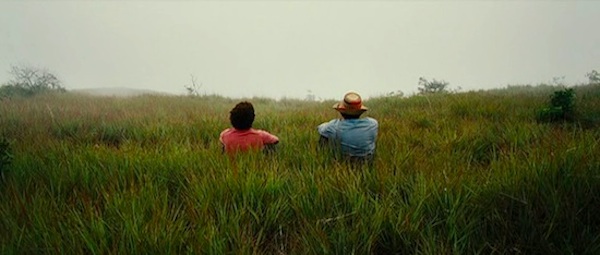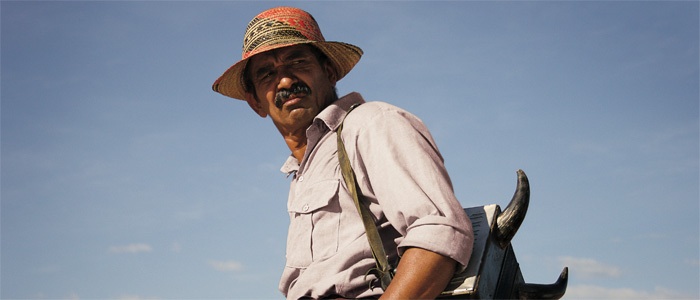“Is that really the devil’s accordion?”
Ignacio Carillo (Marciano Martinez) is a legendary juglar, a wandering troubadour, in his circuit of in the hills and plains and back-country villages of Northern Colombia. His accordion is just as notorious. Two black horns jut out of the instrument, like a bull under the command of a musical matador. It is said to be the devil’s accordion. “It’s not me who plays it,” Ignacio tells his acolyte Fermin (Yull Nunez), a stubborn teenager and aspiring drummer determined to travel Ignacio’s road. “It’s the accordion. I can’t control it. That’s why I have to return it.”
Ignacio is a widower who has vowed to play no more. The film opens with the funeral of his wife and the beginning of his odyssey to return the instrument to his master Guerro. Legends and rumors swirl around the instrument. One is told to Fermin by Nine, Ignacio’s brother, who lives in a hut on a mountain plateau so high that it looks down on the clouds. “The tale of that there instrument is that of Guerra, Ignacio’s master, who won a duel with the devil. The devil, to get his revenge, put a curse on it. Whoever plays it is doomed to be a troubadour. Wandering, playing and singing till the day they die.” Nine pauses, as any good storyteller would, before delivering the punchline. “It is said that the only one who can undo the curse is Master Guerra.” He looks the boy in the eye with a grave expression. “Did you play it?”
The Wind Journeys (Los viajes del viento) plays like the blues legend of the devil at the crossroads as Colombian folklore, a mix of myth, folk song and tall tale set against the grandeur of the Northern Colombian coast and the musical culture of vallenato, the traditional folk music of Colombia’s Caribbean region. The term literally means “born in the valley” and refers to a kind of story song that originated in the 19th century as a way of passing news from village to village through music. Director Ciro Guerra loved vallenato and wrote the film to celebrate the music and the culture around it, creating a road movie where the conveyance is a humble donkey and the road is a path through the plains and mountains to the coast. He cast respected vallenato performer Marciano Martinez as his juglar master. The music, played on accordion accompanied only by voice and the percussion of a drum and guacharaca, becomes the soundtrack of the film, at once energizing and melancholy. As performed by Martinez, it is an earthy, muscular kind of music. His voice is not pretty but it is powerful, communicating years of experience and emotion.
Whether the instrument is truly enchanted or cursed is a question left open to the audience, but there is no denying that there is something both fulfilling and destructive in the life of the juglar. “The accordion was meant to be played solo,” proclaims Nine. “Other instruments can play chords or bass. But only the accordion can do it alone. Alone, like we who play it.” That is the real curse of the instrument and even Ignacio can’t shake the hold it has over him. He insists that he no longer plays, yet is soon engaged in the Colombian answer to a cutting contest or a rap-off and competing in musical competitions in village festivals. When the instrument is taken from him, it’s as if his is soul was taken along with it and he’s lost the will to live.
Ignacio has spent a lifetime tramping the villages of his corner of Northern Colombia, playing festivals and parties and competitions, feeding off the adulation of the crowds and the attentions of the adoring beauties like a rock star. “I have children I don’t even know about,” he confesses to Fermin with regret. Fermin may even be one of them. His father was a musician. Not the man who married his mother and raised him, but his “real” father who spent a night with his mother and moved on. Travelling with Ignacio is a way to connect with the DNA of his paternity, spiritually if not literally. Ignacio tries to discourage him, to return home to his village, Majagual, and the girl he left behind, and to forget about a life of travelling “from party to party, from woman to woman.” Fermin, however, is determined to be a musician. “She’ll wait,” he answers. Perhaps, but as Igancio knows, life won’t.
This is an odyssey in the mythic sense: a quest to retire a debt, mourn a loss and bring closure to a life, and along the way fulfill the age-old tradition of the old man mentoring (however reluctantly) a young boy who becomes his student out of sheer tenacity, and it plays out on an epic canvas. Patton Oswalt, talking about the film with TCM’s Robert Osborne, described it as “a musical Unforgiven.” It’s only the second feature from director Ciro Guerra but he composes his widescreen images with the eye of a master. And like a mythic odyssey, the journey is as magical as it is physical, with stops along the trail as aesthetic as they are physical. From the grasslands of his inland village, he tramps through one astounding landscape after another: vast fields of high pampas grass, lush mountain plateaus like islands floating in the clouds, endless deserts stretching to the horizon, barren hillsides on the crest of the snow line, and stark salt flats by the seas. It’s hard to imagine a trail that would take these two travelers through this succession of locations but, like the tale of the devil’s accordion, this is as much mythical odyssey as literal journey.
Next the grandeur of these natural wonders, the villages are dusty, impoverished places of bare shacks and cheap cantinas. In this hardscrabble rural world of peasants and poverty, where superstition and sorcery is a part of everyday life and duels to the death are not only common but undertaken with musical accompaniment, the master musicians is treated with the respect of a shaman. It’s little wonder that Fermin aspires to become a juglar in his own right. Vallenato brings life and color and excitement to village life. In the isolation of the vast lands between human outposts, the only soundtrack to their existence is the lonely howl of the wind and the roar of the sea.
The Wind Journeys was an official selection of the 2009 Cannes Film Festival, where Guerro earned the Award of the City of Rome, and it won awards for Best Picture and Best Director at the Bogota and Cartagena Film Festivals. But it was little seen outside of the festival circuit despite its acclaim and awards. It’s the cinematic equivalent of an epic folk song, with rich images in place of poetic verses and the slow transformation of a stubborn boy into a courageous young man.







